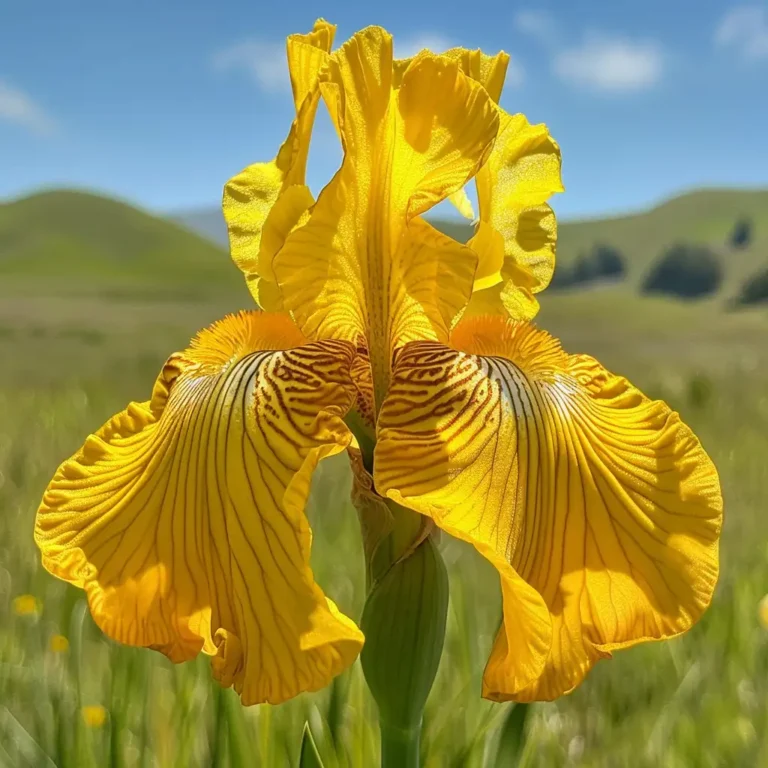Introduction
The Sunshine Iris (Iris pseudacorus), commonly known as the Yellow Flag or Yellow Iris, is a striking plant that stands out with its vibrant yellow flowers and lush green foliage. This aquatic plant, native to Europe, Asia, and North Africa, thrives in wetland areas and has gained popularity worldwide for its beauty and versatility.
Botanical Description
The Sunshine Iris is a herbaceous perennial that features bright yellow flowers measuring up to 4 inches in width. These blooms typically appear in late spring and early summer. The plant’s sword-shaped leaves grow in dense clumps, reaching heights of up to 3 feet. The rhizomatous root system allows it to spread efficiently, making it a robust addition to any garden.
Historical Background
The Sunshine Iris has a rich history of cultivation, dating back to ancient times. It was revered for its ornamental value and its various practical uses. Traditionally, the plant was utilized in different cultures for medicinal purposes and as a natural dye.
Cultivation and Care
Growing Iris pseudacorus is relatively straightforward, provided you meet its basic needs:
- Soil and Light Requirements: Prefers moist, well-drained soil and can tolerate full sun to partial shade.
- Watering and Fertilization: Regular watering is essential, especially in dry conditions. Fertilize in spring with a balanced fertilizer.
- Planting and Propagation: Propagate by division in early spring or late summer. Ensure roots are planted at the right depth to encourage growth.
- Common Pests and Diseases: Watch out for aphids and fungal diseases. Use appropriate treatments to manage these issues.
For more detailed information on cultivation, you can refer to this comprehensive guide.
Ecological Impact
The Sunshine Iris plays a crucial role in its native ecosystems. It provides habitat and food for various wildlife species, including pollinators like bees and butterflies. However, its aggressive growth can sometimes lead to invasiveness, particularly in non-native regions. Effective management practices are essential to control its spread.
Uses in Landscaping
This iris is a favorite in garden design due to its striking appearance and adaptability. It’s ideal for water gardens, pond edges, and wetland areas. Here are some key points to consider:
- Popularity in Garden Design: Its bright flowers and lush foliage make it a focal point in any garden.
- Ideal Conditions: Thrives in sunny locations with adequate moisture.
- Maintenance and Aesthetic Appeal: Minimal maintenance required once established. Regular division keeps the plant healthy and attractive.
For more tips on using Iris pseudacorus in your garden, check out BBC Gardeners’ World Magazine.
Environmental Benefits
The Sunshine Iris offers numerous environmental benefits:
- Water Filtration: Helps in purifying water by absorbing pollutants.
- Erosion Control: Its extensive root system stabilizes soil and prevents erosion.
- Habitat for Wildlife: Provides shelter and food for various species, enhancing biodiversity.
Medicinal and Other Uses
Historically, the Sunshine Iris has been used for its medicinal properties. It was commonly employed in traditional remedies for various ailments. Modern research continues to explore its potential uses in medicine and other fields.
Comparisons with Similar Species
Distinguishing the Sunshine Iris from other species can be challenging. Here are some tips:
- Distinguishing Features: Look for its bright yellow flowers and sword-shaped leaves.
- Comparison with Other Irises: The Sunshine Iris is often confused with Iris versicolor, but the latter has blue or purple flowers.
FAQs
What are the main characteristics of Sunshine Iris?
The Sunshine Iris features bright yellow flowers and dense clumps of sword-shaped leaves. It grows up to 3 feet tall and spreads via rhizomes.
How do I grow and care for Iris pseudacorus?
Ensure it has moist, well-drained soil and full sun to partial shade. Regular watering and annual fertilization will keep it healthy.
What are the environmental benefits of planting Sunshine Iris?
It helps in water filtration, erosion control, and provides habitat for wildlife.
Is Iris pseudacorus invasive?
Yes, it can be invasive in non-native areas. Effective management practices are required to control its spread.
What are some common uses of Sunshine Iris in gardens?
It’s popular in water gardens, pond edges, and wetland areas for its aesthetic appeal and minimal maintenance needs.
Conclusion
The Sunshine Iris (Iris pseudacorus) is a versatile and beautiful plant that can enhance any garden or landscape. Its ecological benefits, historical significance, and ease of cultivation make it a valuable addition to both natural and designed environments. By understanding its needs and managing its growth, gardeners can enjoy the many advantages this striking iris has to offer.

